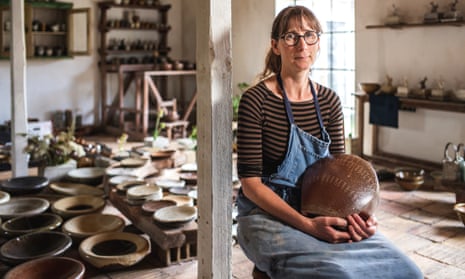In the mid-1960s, my parents abandoned their dark blue Willow Pattern tableware, inspired by a Japanese fairytale, for the more minimal Sienna by Midwinter, a graphic design by Jessie Tait made by William Robinson in Stoke-on-Trent. Considering the design of bare, black twigs and stripes of buff and orange as if we had traded in our staid family saloon for a fast sports car.
After years of trying to find my food among the Chinoiserie trees, birds and cherries of the classic Willow Pattern, I could now actually see my dinner in all its meat-and-two-veg glory. Production of Sienna stopped in 1987 when the company became insolvent, but the design continues to get cameo parts in 1960’s television dramas as the prop stylists’ go-to tableware of the era. What I took away from this was that food looks better, more comfortable, on the right china.
I now eat from a clutter of mismatched pieces. At home, and indeed for the photographs to accompany my recipes, I enjoy choosing plates or bowls that are appropriate for the food. Pieces that will flatter the food rather than detracting from it. My only rule being that the china must never outshine the food. Being a cook, I would say that. I want the ceramics to go almost unnoticed. By which I mean they are both unassuming and flattering to the food rather than just white plates, which are more redolent of restaurant dining than home-cooking. Without even trying, I have built up quite a collection.
I never set out to be a collector of ceramics. This small, heavily edited collection started with a single cup: a small, dark-green, salt-glazed mug by potter Steve Harrison. I liked it because of its shape and weight, but also for its carefully considered details and in particular the handle whose shape perfectly fitted my fingers. I find most mugs too big and too heavy, so large that your tea is cold by the time you get to the bottom. This one held just enough, was the right weight, the rough orange peel texture was interesting to the touch. Being date and signed with the potter’s mark I could feel the hand of the maker on my cup rather than the cold anonymity of a piece of mass-produced china. I guess we all have our favourite mug and this was mine.
Occasionally, a guest will show surprise when I hand them a cup of coffee in a collectible cup by Harrison or the late Lucie Rie and Hans Coper. My reasoning is that the potters’ work was made to be part of a working home and I doubt they intended it to sit, admired but unused, in a museum cabinet. And yet sometimes that is when a piece is at its most beautiful. A pot can sometimes just be a pot. Still, quiet, at peace with itself. A recent exhibition at the V&A focused on Richard Batterham’s work, which had for ever been useful in the kitchen, but was now placed behind glass, as if sleeping. They took on a different beauty and a function. That of simply being a thing of beauty.
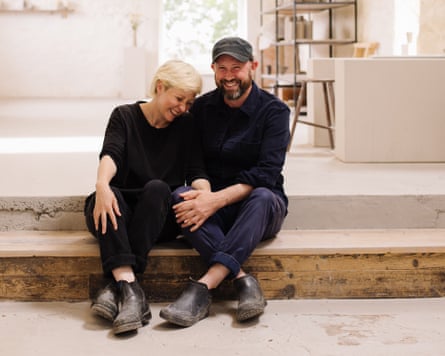
Most of my own collection is studio pottery, the sort of humble pieces that are used on the table and most of which go in and out of the dishwasher on a daily basis. My first pieces were by the late Richard Batterham, bought for their soft glaze, the colour of lichen, and the depth of the plates. Food of almost any sort looks great on them, but particularly anything green. At risk of being “overused” in my books and columns, they are now stored (sleeping, as I call it).
Mass-produced, high street china is good value and can take the rough and tumble of everyday use, but lacks the timeless, handmade quality of that from smaller, privately owned potteries. Despite the interest in small batch production, partly due to a rediscovery of handcrafted products (and no doubt the prime-time success of Great Pottery Throw Down) there is a shortage of modern, hand-thrown ceramics around.
Ceramics by young potters such as Florian Gadsby, Darren Ellis, Jono Smart and Emily Stevens, whose calm, timeless pieces in gentle hues of charcoal, grey and sand are made in a beautiful studio in the foothills of the Cairngorms, all sell within minutes of going online. Working apprenticeships are hard to come by and classes such as those at Clay College in Stoke on-Trent, or Studio Pottery in London are in great demand.
Not everything I live with is purely practical in nature, a receptacle for the serving of food or drink. There are decorative pieces, too. A hand-raised bowl by Jennifer Lee or a row of celadon pots by Edmund de Waal bring a sense of calm in the same way a painting or piece of sculpture might do to a busy and often chaotic space. Some pots and bowls, even cups can have a meditative quality that I appreciate and sometimes need. Their presence, the stillness that they bring to a busy home, slows life down.
Ten years ago, Edmund de Waal made Tea, Fire, Smoke, a work containing 269 small pots, for the main wall in my kitchen. The space was chosen for the light each porcelain piece would receive from an adjacent window. From dawn to dusk, the light and shadows play with the glazes and details of each pot. There is not a day that I am not grateful to be living with it. Art has always had a place in this kitchen.
Do I ever break things? Yes, occasionally. A much-cherished Japanese raku pot narrowly missed a length of falling ceiling only the other day, though accidents are rare. In some cases, the fragility of a piece only adds to the wonder of owning it. The feeling that a slammed door or a surprise gust of wind could render an artist’s work to shrapnel is all part of living with it.
Which brings me to the pieces I have by Scottish potter Jennifer Lee, that seem to float, weightlessly, above the surface on which they sit. Unglazed, their colours come only from her clays, some of which she may have had in store in her studio for 30 years before working them into one of the few pieces she makes each year. These tall, ethereal pots are lightly secured on the base with Museum Wax, which at least gives them a fighting chance against the juddering of a scaffolding lorry or a pneumatic drill on the road outside. I feel a duty to look after things, thinking of myself as custodian rather than an owner, in the hope that one day, such beautiful works will be passed to someone else to enjoy.
All of which seems a long way from the Midwinter china of my childhood, yet all collectors have to start somewhere, I guess. Here are nine potters whose work I admire.
Anne Mette Hjortshøj
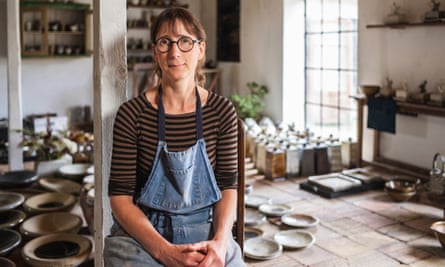
Working on the island of Bornholm, Denmark, Anne Mette uses local clay to make her ruggedly charming bowls, plates, bottles and vases. Her pieces very much echo the local landscape and are in constant daily use in my kitchen. Many a bean casserole has been baked in her deep, soft-hued dishes (goldmarkart.com).
Artik Huseyin

The minimal, monochrome tableware of Turkish artist and potter Artik brings clean, crisp lines to the table. Join his mailing list for news of his latest shop sales. He ships internationally (huseyinartik.com).
Lisa Hammond

Some of the first casseroles and cups I ever bought were by Lisa – and are still in use to this day. The London potter’s luminous soda glazes are instantly recognisable and her regular kiln opening sales are not-to-be-missed events. She’s well known as the founder of Clay College in Stoke and is one of the trustees of Adopt a Potter: ‘Our aim is to safeguard the future of studio pottery by providing a forum for our ageing master craftsmen and women and the best of international makers to pass on their practical wisdom and tangible skills to the next generation of master potters,’ she says (lisahammond-pottery.co.uk).
Akiko Hirai
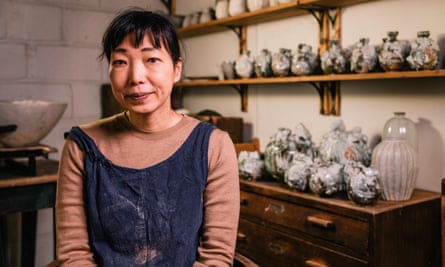
A Japanese-born potter working in London, Akiko is best known for her monumental “broken pots” but she also makes more domestic ware. Her “beautifully imperfect” bowls and platters with crackle glazes are a pleasure to use. Look out for what I call her ‘chiselled’ cups which are a joy to hold (goldmarkart.com).
Jono Smart & Emily Stephen
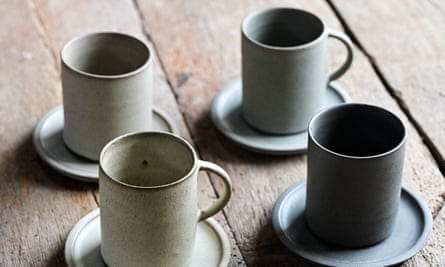
From their studio at the foothills of the Cairngorms, their work is the epitome of timeless and elegant yet deeply functional, and carries something of the ruggedness of their local Scottish landscape, too. Good luck getting hold of their much sought after pieces (jonosmart.co.uk/shop).
Nancy Fuller

Born in rural Taiwan and raised in Scotland, Nancy makes fluted bowls in gorgeous shades of charcoal, amber and brown. Nancy’s bowl is the one from which I drink miso soup on a grey winter’s morning (nancyfuller.co.uk).
Rose Schmits
Well known as the studio technician on the Great Pottery Throw Down, Rose’s pieces, especially her joy-filled tentacle handled cups, are highly collectible (roseschmits.com).
Karen Downing
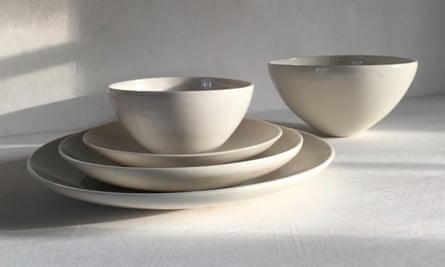
In soft, cream glazes and pleasingly simple shapes, Karen’s bowls, cups and jugs have a quietness to them, but are rugged enough for everyday use. There is something timeless about her pieces (contemporaryceramics.uk).
Isatu Hyde

Working in Ludlow, Shropshire, Isatu’s soft green matt and white celadon glazes are simply gorgeous and I long to have some of her pieces on my table. Her fluted porcelain and stoneware serving bowls are at the very top of my wishlist (isatuhyde.com).
